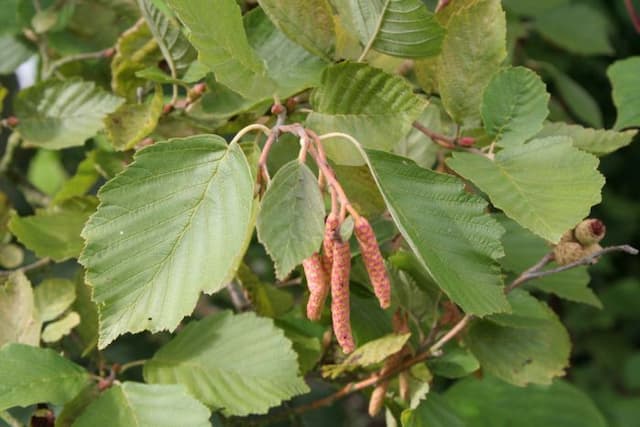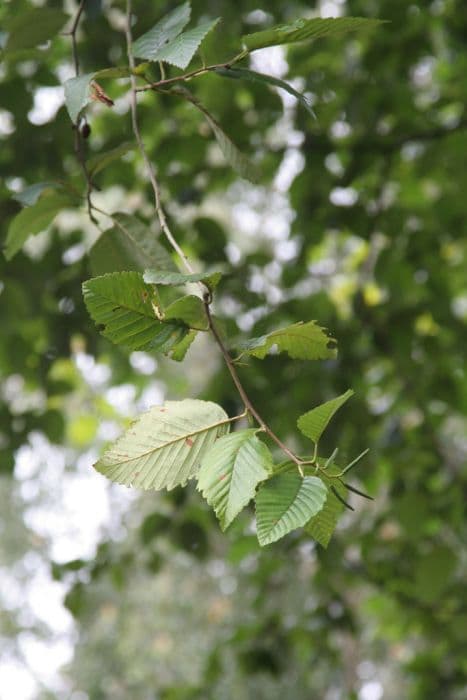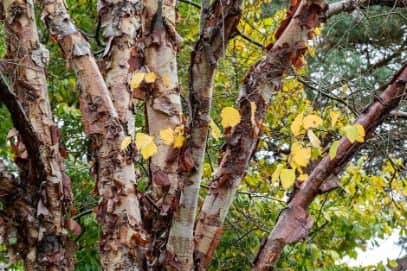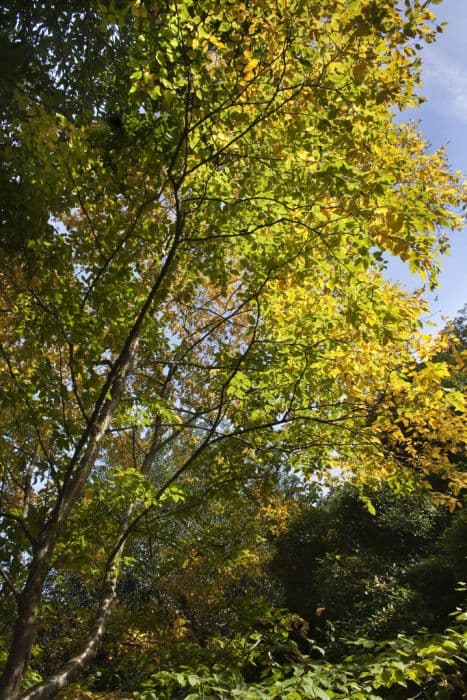Himalayan birch 'Moonbeam' Betula utilis subsp. jacquemontii 'Moonbeam'

ABOUT
A slow-growing deciduous tree with a rounded crown, reaching around 6m in height after 10 years. It is grown mainly for its striking, white, peeling bark
About this plant
 Names
NamesFamily
Betulaceae.
Synonyms
White-barked Himalayan Birch, Jacquemont's Birch, Himalayan Birch, West Himalayan Birch.
Common names
Betula utilis var. jacquemontii, Betula jacquemontii.
 Characteristics
CharacteristicsLife cycle
Perennials
Foliage type
Deciduous
Color of leaves
Green
Height
30 feet [9 meters]
Spread
20 feet [6 meters]
Plant type
Tree
Hardiness zones
7
Native area
Himalayas
Benefits
 General Benefits
General Benefits- Aesthetic Appeal: The 'Moonbeam' variant of Himalayan Birch is known for its striking white bark that peels and creates a beautiful contrast against landscapes.
- Landscape Use: It provides appealing vertical structure in gardens or parks because of its tall and elegant form.
- Winter Interest: Its bright white bark stands out in the landscape during the dormant season, offering visual interest in winter.
- Adaptability: This plant can thrive in a range of soil types, as long as the soil is well-drained.
- Wildlife Habitat: The tree offers shelter and food to various birds and small mammals, enhancing biodiversity.
- Shade: It provides a good amount of shade during the hot summer months, making outdoor spaces more enjoyable.
- Fall Color: During autumn, its leaves turn yellow, adding a seasonal splash of color to the garden.
- Low Maintenance: Once established, Himalayan Birch requires minimal care, making it suitable for busy gardeners.
 Medical Properties
Medical PropertiesThis plant is not used for medical purposes.
 Air-purifying Qualities
Air-purifying QualitiesThis plant is not specifically known for air purifying qualities.
 Other Uses
Other Uses- Woodworking: The wood of the Himalayan birch is fine-grained and can be used to create small wooden items, such as picture frames and handled tools.
- Natural Dyes: The bark of the Himalayan birch can be used to make a light brown or cream dye for coloring wool or textiles.
- Photography Backdrops: The striking white bark of the Himalayan birch 'Moonbeam' creates a stunning contrast in photography, and it is often used as a natural backdrop for portraits and scenic photography.
- Decorative Branches: Cut branches of the Himalayan birch can be used in floral arrangements or as standalone decorations in vases for their ornamental value.
- Garden Focal Point: Due to its unique white bark and striking appearance, the Himalayan birch 'Moonbeam' can be used as a focal point in landscape design.
- Cultural Significance: In certain cultures, parts of the Himalayan birch may be used in traditional ceremonies or crafts as a symbol of protection and purification.
- Birch Sap Products: The sap of the Himalayan birch can be tapped and used to produce syrup, vinegar, or beverages, similar to how maple sap is utilized.
- Bookbinding: The bark of the Himalayan birch is sometimes used as a natural material for the covers of handmade books or journals.
- Winter Garden Interest: The Himalayan birch 'Moonbeam' retains its aesthetic appeal in winter, providing stark beauty and interest in otherwise barren winter gardens.
- Frost Tolerance Research: This particular species of birch can be used in botanical studies to research plant resilience and adaptation to frost and cold climates.
Interesting Facts
 Feng Shui
Feng ShuiThe Himalayan birch is not used in Feng Shui practice.
 Zodiac Sign Compitability
Zodiac Sign CompitabilityThe Himalayan birch is not used in astrology practice.
 Plant Symbolism
Plant Symbolism- Growth and Renewal: As a birch tree, 'Moonbeam' symbolizes new beginnings and growth since birch is often one of the first trees to grow in a cleared area.
- Adaptability: Birch trees can thrive in various climates, reflecting the idea of being adaptable and flexible in life's conditions.
- Purification: In various cultures, birch trees are associated with purification and protection, often used to ward off evil spirits and bad luck.
- Beauty: The striking white bark of Betula utilis jacquemontii 'Moonbeam' represents beauty and uniqueness, as it stands out in the landscape.
 Water
WaterThe Himalayan birch, or Betula utilis var. jacquemontii 'Moonbeam', should be watered deeply and thoroughly, allowing the water to reach the root zone. During the growing season, watering once or twice a week may be necessary, depending on weather conditions. The soil should be kept consistently moist but not waterlogged. Each watering session should consist of approximately 1-2 gallons of water for young trees, increasing the amount as the tree matures. In the winter, reduce the frequency of watering since the plant's water requirements decrease.
 Light
LightHimalayan birch thrives in full sun to partial shade conditions. The ideal location is one where the tree receives at least 6 hours of direct sunlight daily, although it can tolerate some light afternoon shade. Ensure it is planted in a spot that is well exposed to natural light.
 Temperature
TemperatureHimalayan birch can tolerate a wide range of temperatures, from chilly winters to warm summers. The tree is hardy and can survive temperatures as low as -20°F and up to 90°F, making it suitable for many climates. The ideal temperature range for promoting growth is between 50°F and 70°F.
 Pruning
PruningPruning the Himalayan birch is generally done to remove dead or diseased wood, to shape the tree for aesthetic purposes, or to remove any branches that may pose a hazard. It is best to prune in late fall or winter when the tree is dormant. Prune sparingly, as birches do not respond well to heavy pruning.
 Cleaning
CleaningAs needed
 Soil
SoilFor the Himalayan birch, a soil mix with a pH of 6.0 to 6.5 is ideal. This plant prefers well-draining soil rich in organic matter, such as a mix of loam, compost, and sand. Regular mulching can help maintain soil moisture and health.
 Repotting
RepottingHimalayan birch trees do not typically require repotting as they are usually planted directly in the ground. These trees have a fast growth rate and should be given ample space to grow.
 Humidity & Misting
Humidity & MistingHimalayan birches are tolerant to a wide range of humidity levels and do well in outdoor conditions where the humidity fluctuates naturally.
 Suitable locations
Suitable locationsIndoor
Provide bright light, cool temps, and good air circulation.
Outdoor
Plant in full sun to part shade, in moist, well-drained soil.
Hardiness zone
5-7 USDA
 Life cycle
Life cycleThe life of Himalayan Birch 'Moonbeam' begins with seed germination, typically in spring when soil temperatures warm up. Seedlings develop, establishing a root system and sending up shoots that will become the young sapling's trunk and primary branches. As the sapling grows, it undergoes a vigorous period of vegetative growth, characterized by the elongation of the trunk and development of a branching structure, along with the unfurling of its distinctive white-barked limbs and ovate, serrated leaves. After several years, the tree reaches maturity and begins its reproductive phase, producing catkins that contain the flowers; male catkins are long and pendulous, while female catkins are shorter and upright. Following pollination, seeds are produced and dispersed, often by wind, which can lead to new seedlings if they land in a suitable location. The tree can live for many decades, continuing to grow and produce seeds annually, with older trees developing deeply furrowed bark and a stately, broad crown.
 Propogation
PropogationPropogation time
Late Winter-Early Spring
The Himalayan birch, specifically the Betula utilis subsp. jacquemontii 'Moonbeam', is usually propagated by seed or less commonly by cuttings. The most popular method is by sowing seeds, ideally done in late fall to early winter. The seeds require pre-stratification - a process of simulating winter conditions to break dormancy - which involves storing them in moist sand within a cold frame or refrigerator at 34°F to 41°F (1°C to 5°C) for around 60 to 90 days. After stratification, the seeds should be sown in well-draining soil and lightly covered. They will need consistent moisture and should be kept in a cold greenhouse or a similarly cool environment. Germination can be irregular and may require patience, as it might take several weeks or even months. Once the seedlings have grown sufficiently and after the risk of frost has passed, they can be transplanted to their final position in the garden.









